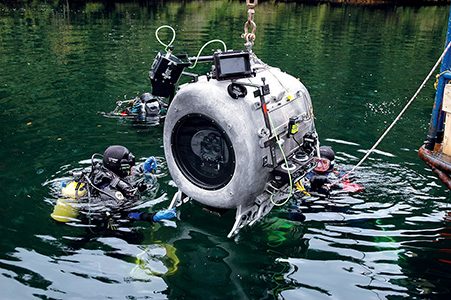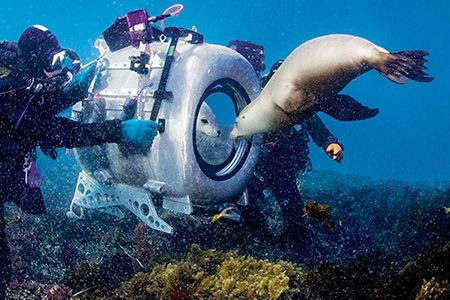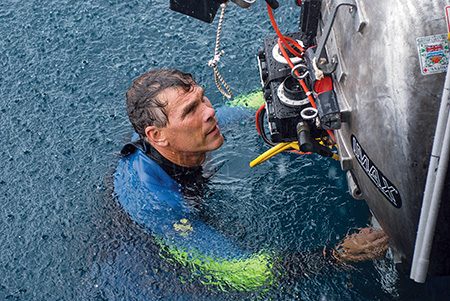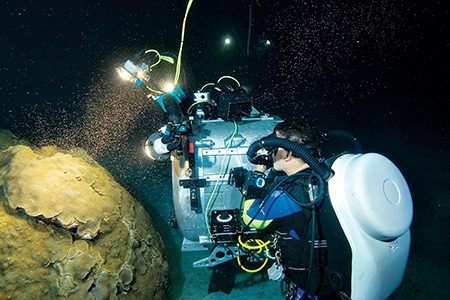In 1992 I received a call from Graeme Ferguson, a co-founder of IMAX Corporation, that changed the course of my career. Ferguson had seen a television film I had made called Seasons of the Sea. It was my first film, and apparently I was the only one surprised when it won Best of Show at the Wildscreen Festival in 1990 and the Jackson Hole Wildlife Film Festival in 1991. By sheer luck, it was the right idea at exactly the right time, and it was mostly in focus.
My wife, Michele, and I sat in stunned silence at a restaurant in San Diego, California, as Ferguson explained that IMAX was building a 3D camera. It would have two lenses, each simultaneously exposing a 1,000-foot (305-meter) roll of 70mm film. The film alone would weigh 20 pounds (9 kilograms). Even with rolls that long, the camera would run for only three minutes before needing a film change. I estimated that the system in an underwater housing would weigh approximately 1,500 pounds (680 kg). I was dumbfounded.
“Do you think you can make a film with something like that?” he asked.
I might have laughed had anyone else asked the question and if it had been less serious. Making an underwater wildlife film with the camera Ferguson described would be extremely challenging or, more likely, hopeless. But I suspended any sense of honesty and integrity and said, “Yes, I think we can do that.” It occurred to me that if the project turned out to be a disaster, I could always go back to television production.
No one would know. Michele was thinking that we could probably afford granite kitchen counters.
Michele and I left the restaurant in stunned silence. I couldn’t imagine any possible way I could make a film with a camera system that heavy. As I pulled away from the restaurant, I noticed in my rearview mirror that Ferguson was standing on the curb with a suitcase. After regaining some of my wits 10 miles (16 kilometers) up the road, I asked Michele, “Were we supposed to take Graeme to the airport?” I got the job anyway.
Making films with such an impractical camera system required lots of innovation. We built special underwater lighting systems powered from the surface via 220-volt cables and a fluid-head tripod that weighed more than 60 pounds (27 kg). We also developed special underwater communications devices with Ocean Technologies Systems (OTS).
Bob Cranston and I had been diving prototype Biomarine rebreathers since 1990. By the time we began working with the IMAX 3D camera, our rebreathers were highly modified and included custom electronics designed by our dive buddy, Dave Forsyth. The nearly unlimited bottom time and reduced decompression obligations when diving closed-circuit rebreathers were invaluable during long dives setting up and operating the huge camera.

The completed underwater 3D system weighed 1,350 pounds (612 kg) and presented many logistical challenges. We required substantial boats and a crew of professional divers and IMAX camera technicians. Our divers consisted of two teams, one of which was the four rebreather divers who went down with the camera. I was the director and cinematographer, and Peter Kragh or Cranston would assist me. The third diver, Mark Thurlow, would use lift bags to move the 60-pound (27-kg) tripod and the 20-pound (9-kg) weights we used to stabilize it. A fourth rebreather diver, often Forsyth, would manage the light cables.
When we needed a film or lens change, we used our OTS underwater communications to contact the boat. The second team of two launch and recovery divers on open circuit would descend to recover the camera for servicing, which they could do relatively quickly because they had no decompression obligation and could go straight to the surface. A film change usually took about 30 minutes. The rebreather team would often wait on the bottom and prepare for the next shot.
As you might imagine, the underwater IMAX system’s size and mass could prove problematic when trying to capture intimate animal behaviors. An IMAX camera takes about four seconds to ramp up to full speed, so to capture an animal doing something interesting, I had to anticipate the behavior by more than four seconds. Additionally, IMAX cameras sound like lawn mowers. If an animal was complacent enough to stay put as my crew and I mounted the massive camera on the tripod and added the blazingly bright movie lights, the noise of the camera beginning to run was often enough to trigger a flight response. We joked that the ideal subjects for IMAX 3D were sessile invertebrates.


As producer, Michele had huge logistical challenges as well. During production of Under the Sea 3D, we shipped 8,000 pounds (3,629 kg) of equipment to two locations in Australia, two in Papua New Guinea, and one in Indonesia, requiring 60 different permits.
The logistical planning at each stage had to be immaculate. Since the camera was too heavy for anyone to move by hand, each transfer required a crane or forklift to manage the housing. Docks had to be strong enough to take the weight of a truck, and boats needed to have cranes or substantial davits, so Michele had to ask all the right questions. Before we flew the gear into a tiny gravel airport in New Guinea, Michele had asked if the airport had a forklift and was told it did. But when the charter landed and we asked for the forklift, we were directed to a rusting pile of junk overgrown with weeds. The next time she made a point of adding, “Does it work?”
Working in the IMAX 2D format also presented challenges. In 2000 MacGillivray Freeman Films asked me to write and direct the underwater sequences for a film called Coral Reef Adventure. The idea was to feature me and my heroic crew at work doing adventurous stuff. I felt that if we were going to call the film an adventure, it should be the real thing. I decided it would be very adventurous to take IMAX cameras below 300 feet (91 m) to film Richard Pyle, PhD, searching for new species. Cranston, Thurlow, Forsyth, and I went to Hawaiʻi for trimix training from Pyle and Joe Dituri.

Cranston and I had to figure out how to take the IMAX 2D camera to nearly 400 feet (122 m) in a 250-pound (113-kg) housing with a pressure limit of 140 feet (43 m). The solution was to pressurize the housings. We drilled holes in two IMAX housings and attached a scuba regulator to allow the housing to “inhale” as we descended. We attached two 30-cubic-foot tanks to the housing’s bottom, and down we went. We did 21 trimix dives as deep as 375 feet (114 m) while operating two IMAX cameras.
Despite the impracticality of working in IMAX 70mm film, I totally loved it. Operating the huge cameras made the diving endlessly challenging and fascinating. And against all odds, our first IMAX 3D film, Into the Deep, was released in 1994 to great critical acclaim, eventually grossing more than $75 million at the box office. I directed three more IMAX 3D films, including Deep Sea 3D and Under the Sea 3D.


Producing 70mm films in the golden age of IMAX meant giant cameras, multi-million-dollar budgets, and blessedly little competition. That all changed with the digital revolution. IMAX theaters now have digital 4K projectors. Most high-end digital still cameras can capture motion picture images in 4K or even 8K. Today you could probably make an IMAX movie with your phone, but not all 4K images are the same. A 20-second 4K digital video might have a file size of a few megabytes or several gigabytes, depending on the file type and compression. To produce the highest-quality motion pictures, there are advantages to the larger file types created by sophisticated, dedicated cinema cameras.
In 2019 Jonathan Bird and I decided to collaborate on Secrets of the Sea 3D. His first IMAX feature, Ancient Caves, had won Best Film–Short Subject, Best Cinematography, and Best Film for Lifelong Learning at the Giant Screen Cinema Association (GSCA) conference, and he wanted to build on that success. It was a good partnership. We agreed that my responsibilities would include all the fun aspects of underwater filmmaking, and his would include all the miserable and boring technical stuff.


A lot had changed in the IMAX business in the almost 10 years since the release of my last 70mm film. Instead of using one massive IMAX 3D camera with a crew of 12, we used digital 8K RED cameras in housings that weighed only 30 pounds (14 kg) and cost nothing to operate. Because the cameras were small and silent, a whole ocean of subjects became candidates for characters in our film. Making an IMAX movie had become much easier technically, and more people were making them.
Then COVID-19 struck. Many theaters closed, and audiences stopped going to movies. At the same time, the market was flooded with digital IMAX movies. Secrets of the Sea 3D won Best Film–Short Subject at GSCA’s 2023 conference, but after a year in distribution the film has yet to make us enough money to buy a burger. I’m hopeful the industry will turn around now that the pandemic has released its grip.
Optimistically, Bird and I are already working on the next film. I don’t know if it will be profitable, but I’m sure it will be fun. I love the work and can’t think of anything else I would rather do.
Explore More
Enjoy some of Howard Hall’s film work in these videos.
© Alert Diver – Q3 2024